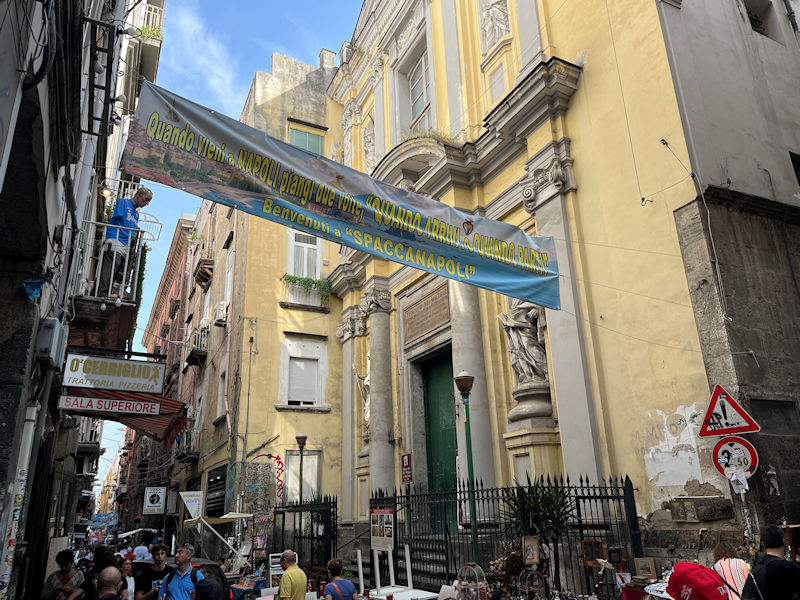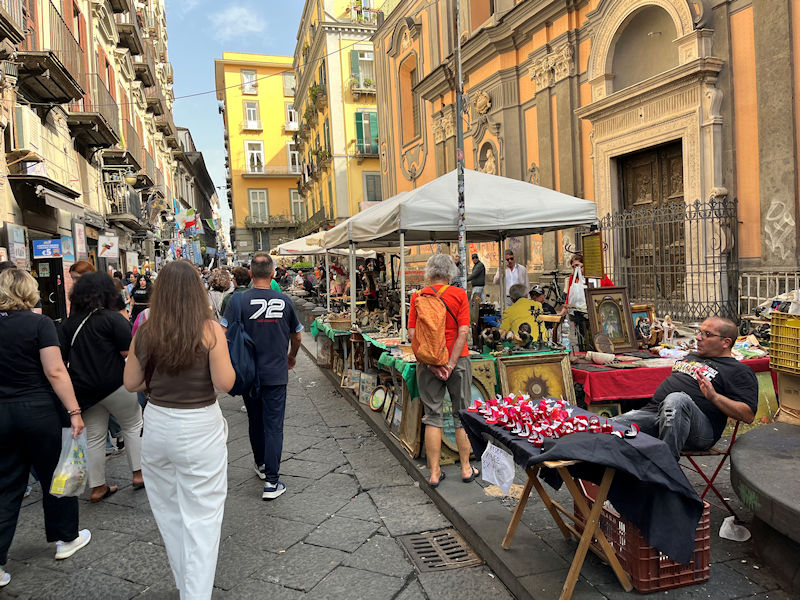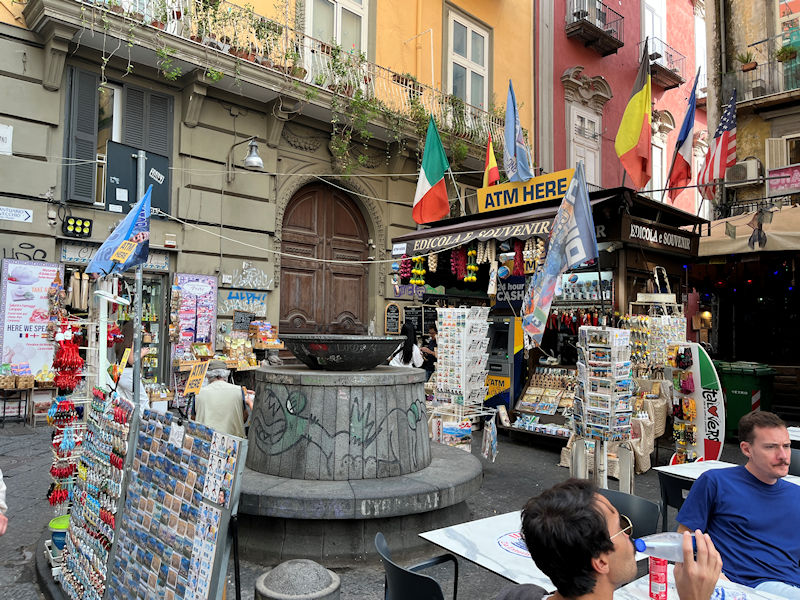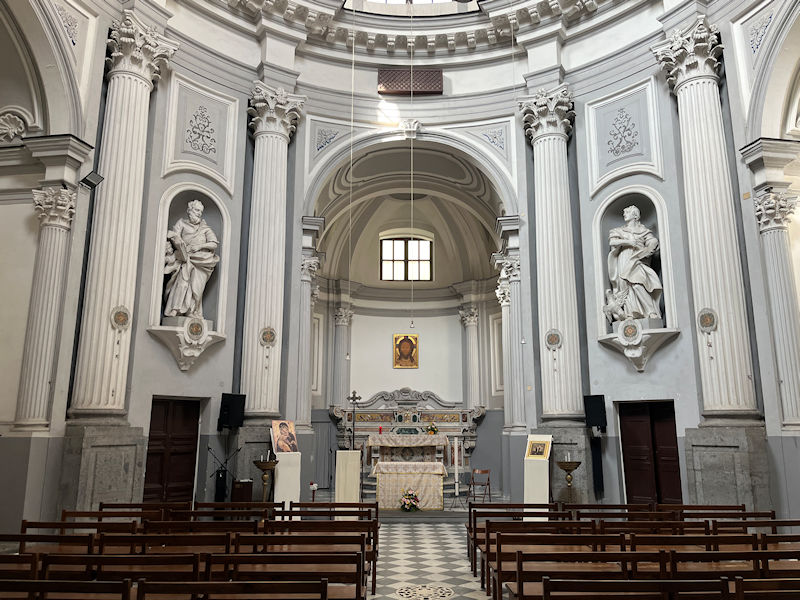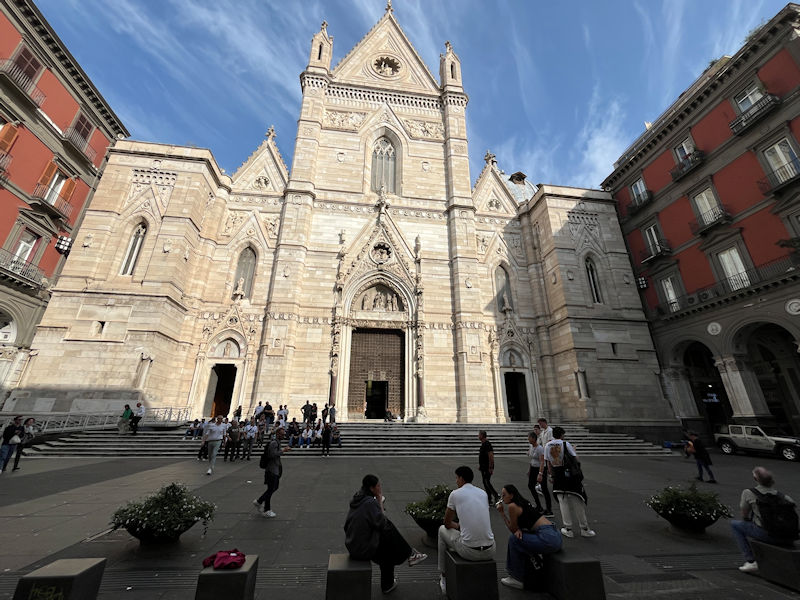You may not find this terribly rewarding unless you're included here, so this is a good time for casual and random browsers to turn back before they get too caught up in the sweep and majesty of the proceedings and can't let go.

The Background: An enormous amount of confiscated ammonium nitrate had been stored in the Port of Beirut 'without proper safety measures' for six years before exploding on 4 August 2020, causing 218 deaths, 7,000 injuries, and leaving 300,000 people homeless. Amongst the damaged buildings were the 160-year-old Sursock Palace and the Sursock Museum, both of which were important cultural heritage sites, and amongst that damage was a sensitive painting of Mary Magdalene by Artemisia Gentileschi, one of the lesser known amongst the several different ones she did of the Magdalene, this one apparently dated to 1630-1635.
We're prepared to overcome any obstacles to see the exhibition uptown celebrating the picture's restoration and return to Naples, in the Complesso Monumentale di Santa Chiara, the St Clara church and monastery adjacent to the Piazza del Gesù Nuovo.

So, it's up-and-at 'em early (though not too early) (about lunchtime).

-- You stay right there, Big Guy!

We're circumambulating the Borgo and trying to count up the restaurants and bars.
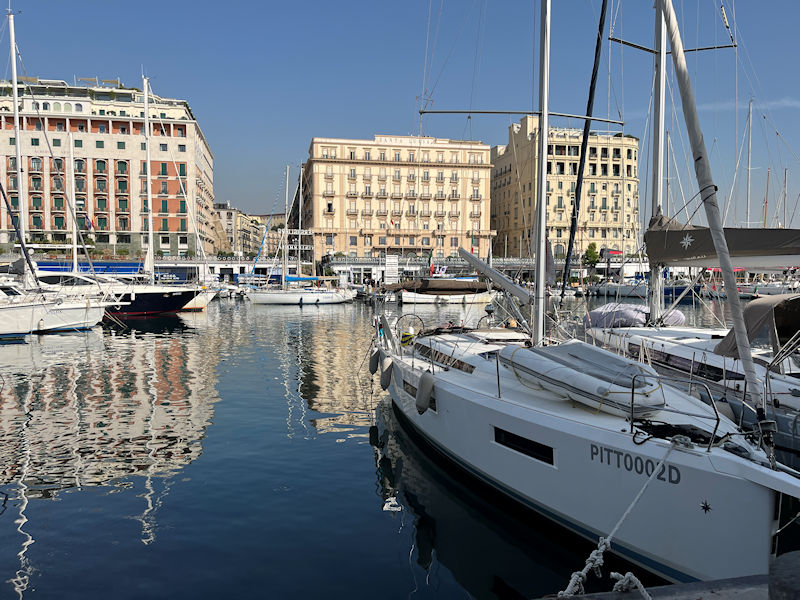
Hotel Row on the Partenope boulevard on the 'mainland'

More restaurants along this side, and there's the bridge on the causeway that makes this, arguably, an island after all.

More restaurants (and the castle)

Kristin's pointed out that all or most of the buildings out here in the Borgo have basically the same architecture.

See?

A brisk pace up the Via St Lucia, headed for . . .

. . . the Piazza del Plebiscito, with the Basilica di San Francesco da Paola anchoring the semi-circle, and tents going up for some kind of public event. We're probably standing right on top of the automobile Tunnel della Vittoria that connects the port area with the other side of Monte Echia.

And facing onto the Piazza, that's the 17th century Royal Palace of Naples.

We've never looked in here before, and will scurry in for a quick peek (we're on a mission and must stay focused).

Nice big front door

About what we expected. The massive buildings, literally the home of the Bourbons for a long time, then of Joseph Bonaparte 1806-1815, then the Savoyard ruling family of Italy, and in 1919 the Savoy monarch Victor Emmanuel III ceded it to the state.

Since 1924 it's been a home of a National Library (the third largest, after Rome and Florence) and a tourist museum of the Royal Apartments.

But we really must get going now.

Amongst all of the historical statuary across the front of the palace, we'll offer just our favorite old-timer, Frederick II Hohenstaufen, the Holy Roman Emperor 1220-1250, aka 'Stupor Mundi'!

The Piazza as we leave it

Across the nearby Piazza Trieste e Trento, that New Glam ad is plastered right onto a drawing of the Chiesa di San Ferdinando, which is plastered right over the actual Chiesa di San Ferdinando. Not a bad church, good location, and prominent in the Commissario Ricciardi series, episode 1.
Some pictures of the interior, and its famous Presepe, are here, towards the bottom of the page (and of course elsewhere on the Internet)

The start of Via Toledo, one of the main shopping streets, named for Pedro Álvarez de Toledo y Zúñiga (1484-1553), the first effective Spanish Viceroy of Naples, 1532-1552.

A passing peek into the shopping Galleria Umberto I (built 1887-1890)

Side streets up toward the Spanish Quarter

That's the Gallerie d'Italia - Naples, opened in 1940 as the HQ of the Banco di Napoli and inaugurated in May 2022 as a new Galleria d'Italia, Napoli for the corporation Intesa Sanpaolo's chain of art museums in Milan, Vicenza, and Torino. There is amazing stuff inside, including Caravaggio, Artemisia Gentileschi, any number of our favorites.
Our visit inside last year can be seen here.

The crowded Spanish Quarter runs up towards the bottom of the Vomero hill -- it was built in the 16th century to house the Spanish garrison helping Viceroy Toledo y Zúñiga keep the native population alert.

Procuring some inexpensive metro tickets
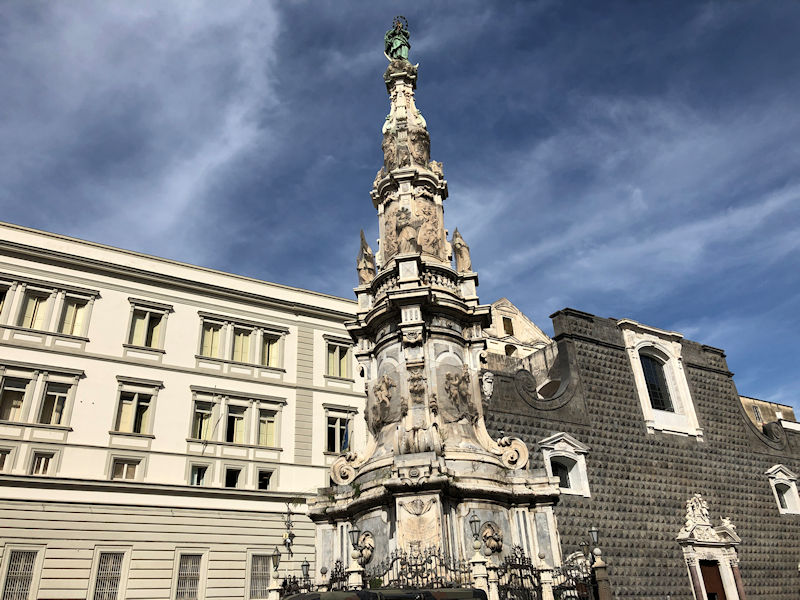
The Guglia dell'Immacolata (Spire of the Immaculate Conception) -- 'Striking 18th-century monument standing 111 ft. & featuring detailed baroque ornamentation'. No kidding!
[Photo from an earlier visit]

The Piazza del Gesù Nuovo, with the Gesù Nuovo church on the left, and the 'Complesso Monumentale di Santa Chiara in Napoli' straight ahead.
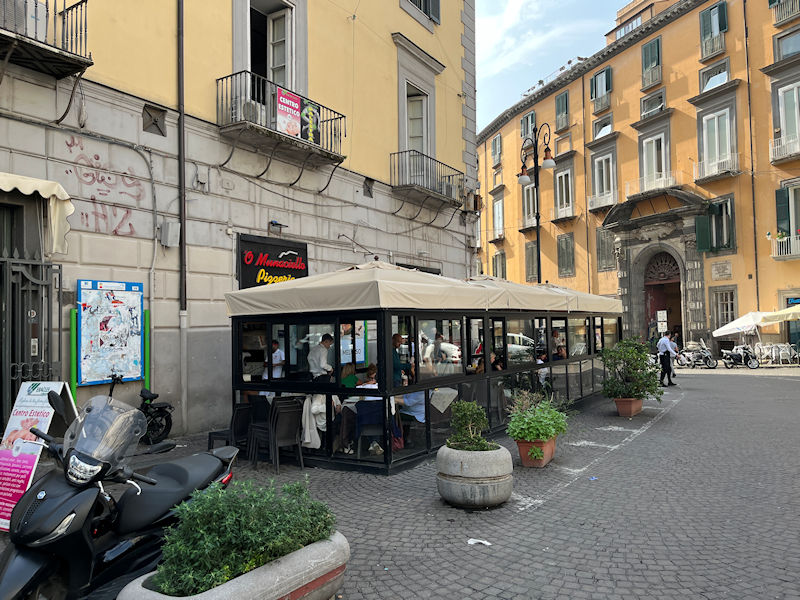
First, a little lunch
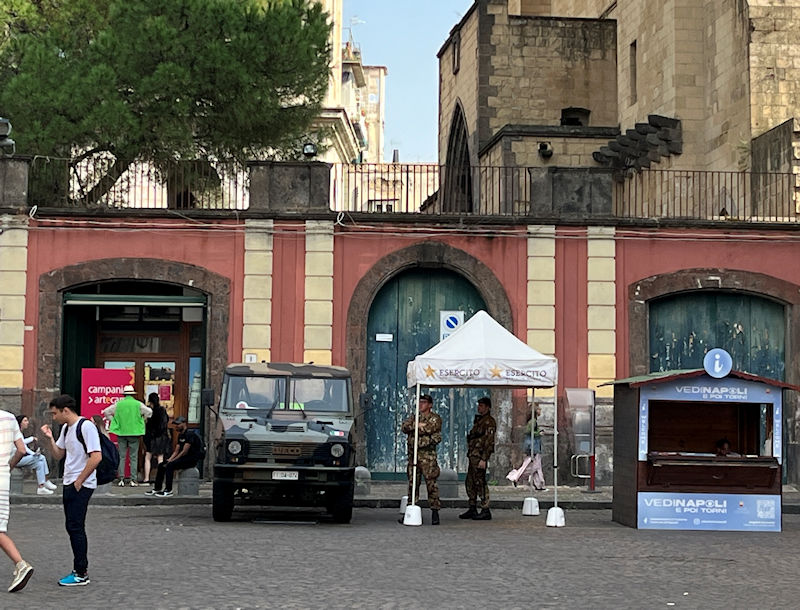
A boring job, no doubt, but someone has to do it.
Our Operazione 'Strade Secure' protection squad may be contemplating their own lunch breaks, soon.
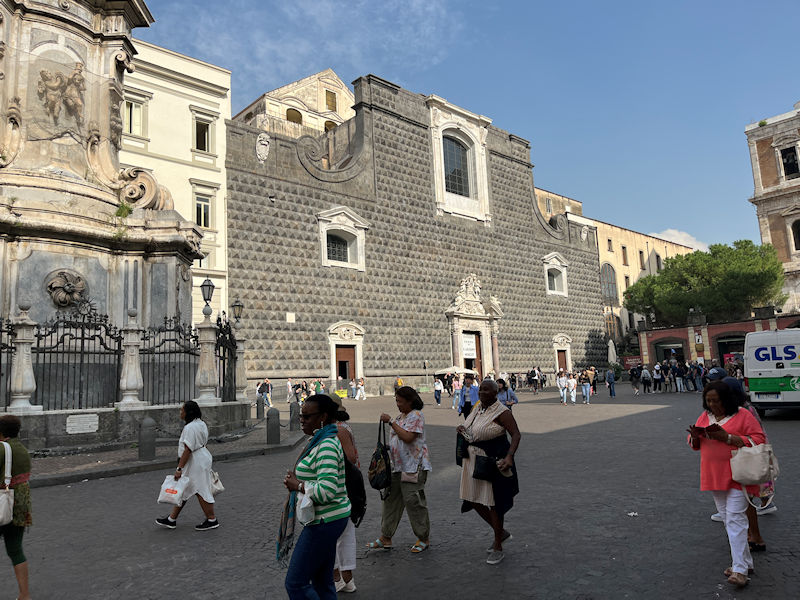
The Piazza del Gesù Nuovo is officially the starting point of the 'Via Spaccanapoli', the 'Naples Splitter' street, that runs 2 km in a straight line to the east 'splitting' the old centre of town, called the Via Benedetto Croce at this end and a few other names farther on where it crosses the Via Duomo. It's the lowest of the three decumani (the Decumanus Inferiore), the main east-west streets of the ancient Greco-Roman grid of Neapolis. The central one, the main Decumanus Maggiore, runs parallel along what's now called the Via dei Tribunali, past the Duomo, and the northernmost runs along the Via della Sapienza roughly from the Academy of Fine Arts.

The site originally held a palace built in 1470 for the Sanseverino family, immediately outside the city limits until the expansion of the early 16th century. The property was confiscated from the unhappy family and in 1580s sold to the Jesuits, who built the church, 1584-1601, retaining the unusual façade from the palace of the 'rustic ashlar diamond projections'.
The Society of Jesus was expelled from Naples in 1767, and the church was taken over by the Franciscans. (The Jesuits came back in 1821 but were booted out again in 1848.) It's administered now by the Archdiocese of Naples.

The inside of the dome was painted by Giovanni Lanfranco but the frescoes were destroyed in an earthquake of 1688 and Paolo de Matteis then repainted a new dome.

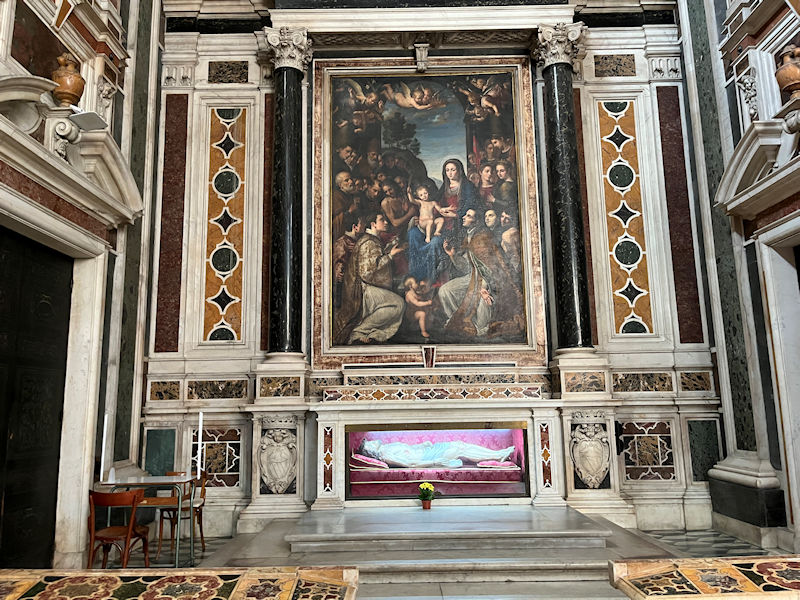
There are more photos of the Gesù Nuovo here, from a previous visit. At the moment, we're in a hurry.

Here, across the street, is what we've really come for. As described at the head of this webpage, the horrible explosion of improperly stored chemicals in the Port of Beirut in August 2020 badly damaged, amongst many other buildings, the 160 year old Sursock Palace, including a painting of the Magdalene by Artemsia Gentileschi. And now it's being ceremoniously exhibited here: 'A grand return to Naples after 400 years'.

First, a look into the church of Santa Chiara (St Clare)
Our caption from an earlier visit: 'The complex was originally built by Robert the Wise, the third Angevin King of Naples (r. 1309-1343), and his second wife Sancha of Majorca, carried out from 1313 to 1340. It was created as a 'double monastery', i.e., including males and females in separated facilities, and embodied the huge church itself, the monastery and its cloisters, and tombs of various worthies including Robert himself and the 19th century last Bourbon king, Francis II. There is presently an archaeological museum as part of it. The separate belltower was begun in 1328 but not completed for many years.'

The nave with two aisles, with nine side chapels on each side. There is no apse -- the high altar sits by the far wall, in front of the tomb of King Robert the Wise. The original church in Angevin Gothic style was redecorated by Domenico Antonio Vaccaro in a 17th century Baroque style. The church was very badly damaged by Allied bombing in 1943, and a controversial restoration to its original pre-Baroque state was completed in 1953.

After the bombardments, the church looked like this, and the monastery was basically leveled. There is a museum on the premises with photos of all the damage and the reconstruction efforts.

Luckily, some of the original features have survived.

The beautiful monastic cloisters, with . . .

. . . their amazing Rococò majolica tiles featuring scenes of a fantasy countryside, hand-painted by Donato and Giuseppe Massa and added by Vaccaro in 1742.


Here we are.
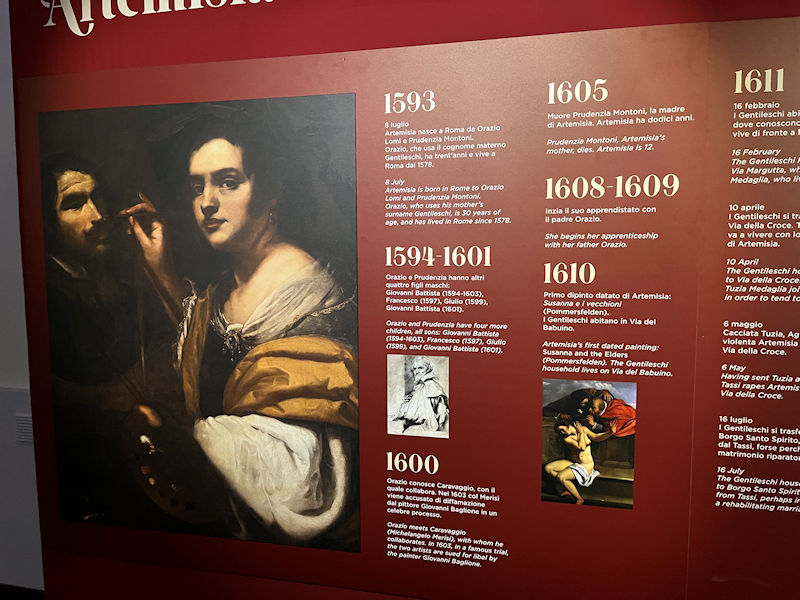
No expenses spared -- a whole wall covered by this chronological survey of Artemisia's life (1593-1653). The painting reproduced here is called 'Allegory of Painting' and is assumed to be a self-portrait of Artemisia (of which there are quite a few), and the subject of the painting could well be her friend and colleague the Frenchman Simon Vouet, who was working in Rome in the 1620s.

There are a couple of short videos on Artemisia, on the artistic traditions about Mary Magdalene, and . . .

. . . about the destruction wrought on the Sursock Palace in 2020. The Guardian at the time had a thorough feature with a collection of pretty sobering photographs: https://www.theguardian.com/world/gallery/2020/aug/13/beirut-explosion-devastates-sursock-palace-and-museum-in-pictures

Here's what we came for. Not the most stirring of Artemisia's many works, but very interesting nonetheless -- in so many ways, it runs across the usual symbolisms associated with the Magdalene's pictures. The urn of precious oil is there (there was a mistaken assumption that she was the lady who anointed Jesus's feet with precious oil), and she's broken off her necklace, suggesting a confident change from her former life perhaps.

That was fun. Now, since we're here, we'll stop in at the museum, closed the other times we've passed through.

Up on the first floor, which runs along like a balcony or galleria above the ground floor.

The museum features, in large part, artistic and archaeological items that could be salvaged after 400 American Boeing B-17 Flying Fortress aircraft on 4 August 2943 targeted the Axis submarine base in the port and somehow wrecked the church and monastery here.
Overall, from 1940 to 1944, American and British warplanes conducted 200 air raids on Naples: 181 of them came in 1943 before the Allied occupation of the city in early October, with between 20,000 and 25,000 civilian casualties. Only Milan got whacked more often than that.

This fellow obviously felt very badly about the whole thing.



There's not a great lot here, but it's all very well presented. The gift and book shop is just through that open door in the back.

It seems to be time for us to leave.

Just a quick look in at the monastery's collection of presepi, or nativity scenes.
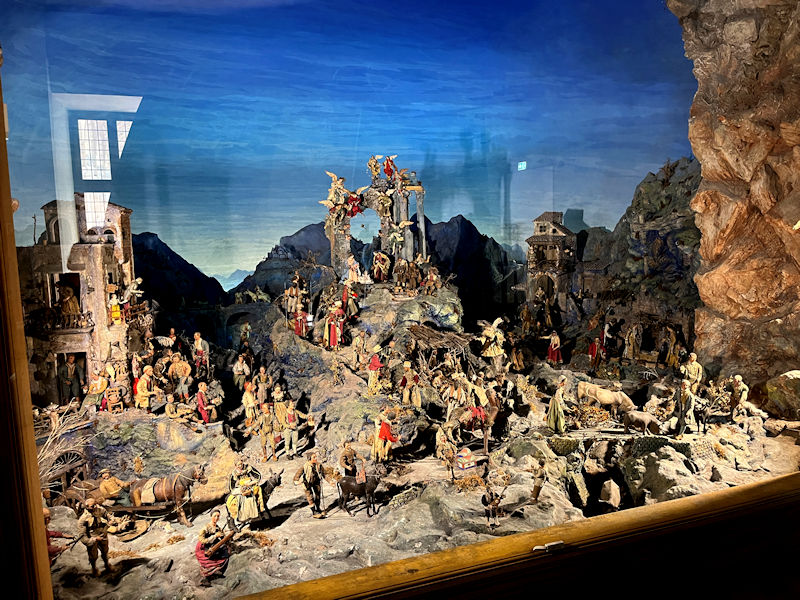
Like that one
 Dwight Peck's personal website
Dwight Peck's personal website




























































